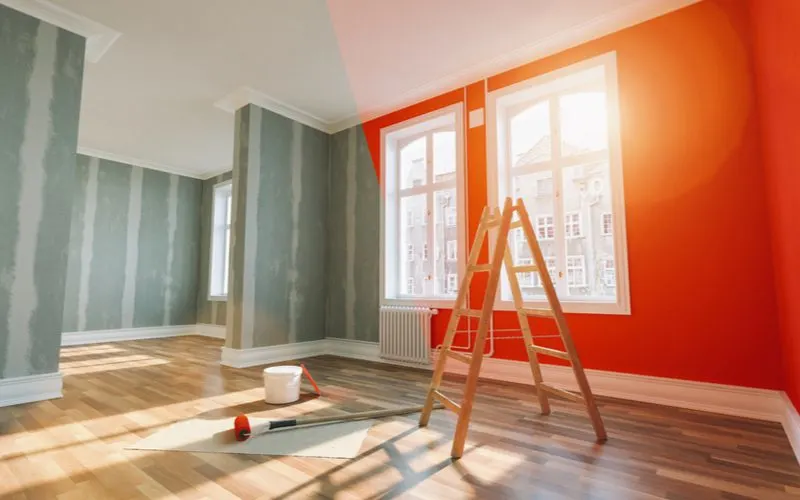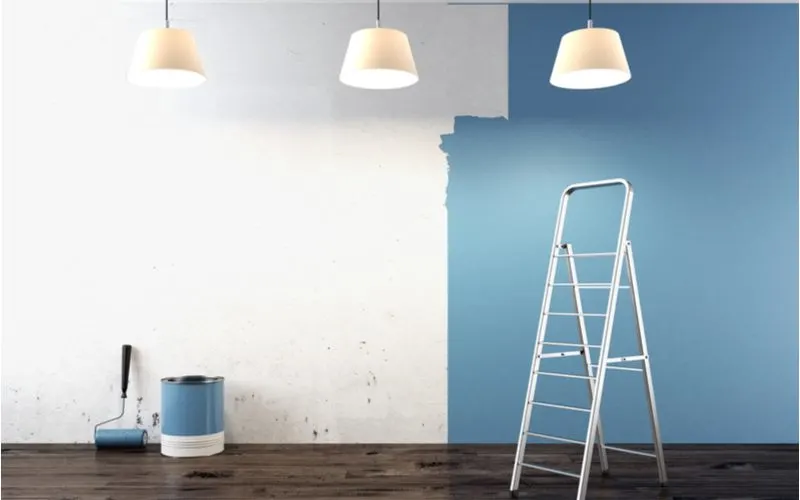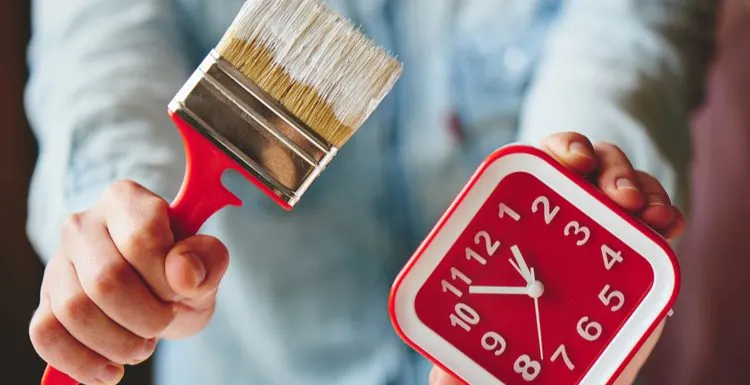Painting can be time-consuming, and you may feel impatient to get it done quickly. Knowing how long to let paint dry between coats can be tricky.
There are many factors to consider here, such as temperature, humidity, the type of paint, whether the paint is oil- or water-based, and the thickness of the paint.
Keep reading to understand the necessary time frame for the paint to dry between coats.
How Long Does It Take For Paint To Dry Between Coats?
Before applying the second coat, you want to ensure that the first has completely dried.
The typical rule of thumb is to wait approximately 3–6 hours before applying the second for water-based paint and 24 hours for oil-based paint.
Paint Drying Process

r.classen/Shutterstock
The paint drying process is just that—a process. While it may not seem like it, there is an art to painting walls and ensuring you wait the necessary time frame before adding a second coat.
If you do not wait until the paint is completely dry, it can create an unwanted outcome.
First Coat Dry Time
Allowing the first coat of paint to dry is one of the most vital steps to ensuring the quality of the paint job on your wall.
It takes approximately 30 to 90 minutes for the first coat of paint to dry to the touch if applied evenly with a paint roller or sprayer.
This period may vary depending on the type of paint used and the thickness. The type, temperature, humidity, and overall thickness of the paint also have an impact on drying time.
Second Coat of Paint
While the initial drying time of the first coat of paint may not seem like a long time, the time you have to wait before applying a second coat is.
Paint typically feels dry to the touch in approximately 60 minutes, but you shouldn’t put on the second coat until much later. If you apply the second coat of paint too soon, there could end up being visible streaks or uneven coloring.
In the worst-case scenario, the paint could start peeling. These side effects can ruin your paint job and end up costing you more money than you intended to spend on your paint project.
The general rule of thumb is to wait at least three hours before adding a second coat of water-based paint or primer and 24 hours for oil-based paints. Waiting for these respective timeframes ensures the paint is fully dry and won’t interfere with the second coat.
Curing Time
Curing time is the time it takes for the paint to completely harden. Giving paint time to cure ensures it resists scratching and chipping.
While it is best practice to allow the paint to dry anywhere from 3 hours to a full day before adding a second coat, you must wait at least a week before moving furniture up against the wall or attempting to clean the wall.
While it is not ideal, waiting one to three weeks before moving back into the freshly painted room will ensure you get the most of your paint job.
If you move your furniture into the room and place it against the wall, the paint is subject to chipping or scratching. Similarly, if you wipe down the wall with a wet cloth, the paint may still smear or scratch, leaving you with another paint repair job.
Things to Consider

Kostsov/Shutterstock
As with any home project, you will need to factor specific considerations into the painting process, including the type of paint used, application method, paint thickness, technique, paint color, temperature, and humidity.
Flat vs. Glossy Paint
The formula that makes up paint contains binders designed to hold the pigment together.
Paint binders play a role in the drying process. Flat paints have less pigment than glossy paints, meaning they have a faster drying time.
In turn, glossy paint with more pigment takes longer to dry. Flat or matte paints take approximately 30 minutes to 1 hour to dry, while glossy paint takes up to 1.5 hours to dry.
Oil vs. Water-Based Paint
Because oil-based and water-based paints are composed of different materials, they have varying drying times.
The water-based paint dries much faster than the oil-based paint because of the evaporation of the water as the paint sits in the open.
Temperature and Humidity
Whether you are painting indoors or outdoors, the temperature and humidity play a role in the drying time.
To get the most out of your paint, it is in your best interest to read the manufacturer’s recommendation for temperature before painting.
Here are some additional factors to consider regarding temperature and humidity when painting:
- The optimal drying temperature for water-based paint is 72 degrees Fahrenheit with some humidity.
- Oil-based paints’ optimal drying temperatures range anywhere from 50 degrees Fahrenheit to below 90 degrees.
- While painting in colder temperatures or high humidity, the paint drying times will increase if it is water-based, as the water cannot evaporate into the air.
- Using a fan to circulate the air in the room that is being painted will help the paint dry faster.
- If it is not too cold, hot, or humid outside, consider opening windows to promote air circulation.
If you are working on a paint job using oil-based paints and are short on time, consider adding a siccative to the paint. Siccative is an oil-drying agent that contains linseed oil and alkyd resin. This helps the oil-based paint oxidize and harden faster.
The Thickness of the Paint
As previously mentioned, the thickness of the paint plays an integral role in the drying process.
If you paint your wall with a paintbrush, the paint will be thicker than if applied with a paint roller. Therefore, the thicker paint will take longer to dry.
It is also vital to note that if the thickness of the paint is uneven across the wall, drying times may take longer across the board.
When this happens, it is vital to wait until the entire wall has completely dried before adding the second coat.
Application Method
As previously stated, the way you apply the paint makes a considerable difference in its overall drying times.
If using a sprayer to apply the paint, you may experience quicker drying times as the sprayer ensures a thin and even coat of paint.
If the paint is applied using a roller, it goes on thicker than the paint that is sprayed on but is consistent with the evenness of the coat. This makes it take longer to dry, but it still dries evenly.
A brush application bears the most inconsistencies with drying time. Paintbrush application goes on thick and uneven if not applied carefully. This means that the drying times increase and may vary across the wall.
Technique
To ensure the application of the paint is even, you must apply the second coat of paint in the same pattern as the first. The best painting practice is to paint all edges first using a paintbrush.
Then use a roller to paint the remaining wall. Painting in a large “W” pattern helps ensure an even coat. As previously stated, an even coat of paint dries better than an uneven coat.
Paint Color
Believe it or not, the paint color plays a role in how long it takes to paint a room and how many coats are necessary.
If you change the paint color from a light color to a darker color, you will most likely only need two coats of paint.
If updating the color from dark to light paint, you may need 4-6 coats. Using a primer when going from dark to light paint will help ensure even coverage. More coats of paint mean more drying time, resulting in a time-consuming task.
Frequently Asked Questions

Stokkete/Shutterstock
What happens if you apply a second coat of paint too soon?
If the second coat of paint is applied too soon, it can result in streaks, uneven coloring, and even peeling paint. While waiting for the first coat of paint to dry is time-consuming, not waiting can ruin the entire paint job and end up as an expensive repair.
Are four coats of paint too much?
The more coats of paint you use, the longer the paint will last if applied properly. Generally speaking, two coats of paint will do the job as that is required to completely cover the wall.
Do I really need to wait 4 hours between coats of paint?
The wait time for the paint to dry depends on the type of paint and the layer of thickness to which it is applied. However, it is important to wait at least 3-4 hours to apply the second coat of paint to ensure the paint has completely dried and it does not affect the first coat.
How long until the paint dries to true color?
Colored paint dries to its true color once it has completely dried. Oil-based paint typically takes 6-8 hours to fully dry, and latex paint takes approximately 4 hours.
Do multiple coats of paint make it darker?
While applying the second coat of paint does not make the paint darker, it can appear more vibrant. This is in part due to a thin first layer of paint over a white primer.
How many times can a wall be painted?
There are no limits to how many times a wall can be painted. However, if you continue to cover the wall with a new layer of paint, the paint will build up and could bulge out or even change the color of the intended paint. If this is a concern, you can sand off the previous layers of paint before applying the new one.
So, How Long Should Paint Dry Between Coats?
There is no cut-and-dry answer on how long to let the paint dry between coats due to the many factors that play a role in the drying process.
For instance, water-based paint dries faster than oil-based paints due to water evaporation rates.
For faster paint drying times, use a paint roller or sprayer instead of a brush and open any exterior windows—if weather and humidity cooperate—to promote air circulation or turn on a fan in the room.
It is vital to let the first coat of paint dry completely before adding another to ensure paint quality so you can enjoy your freshly painted room.

